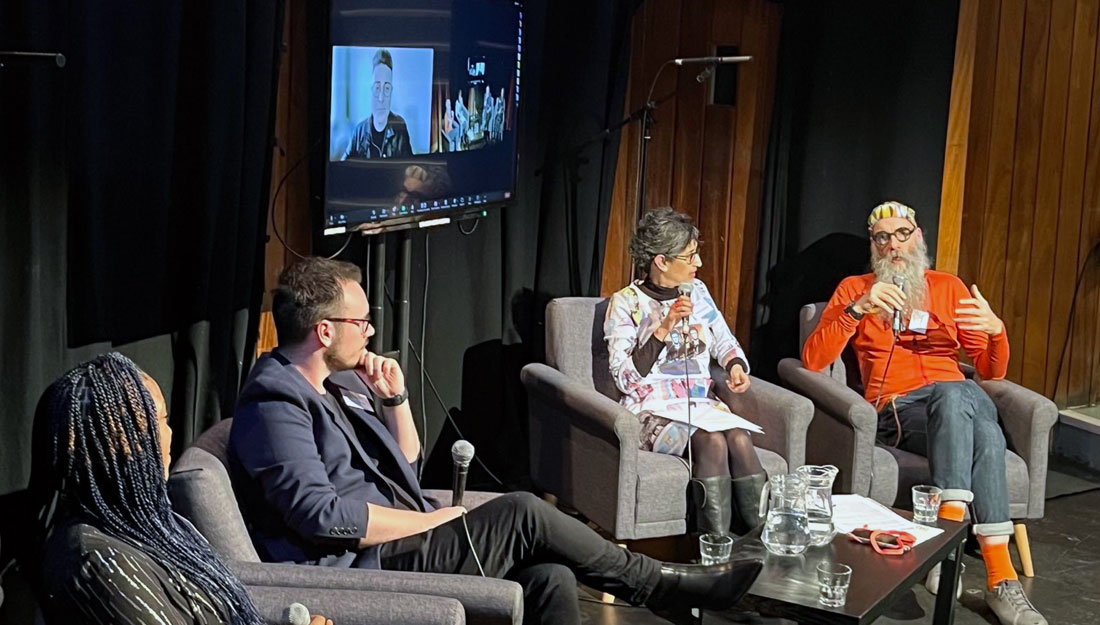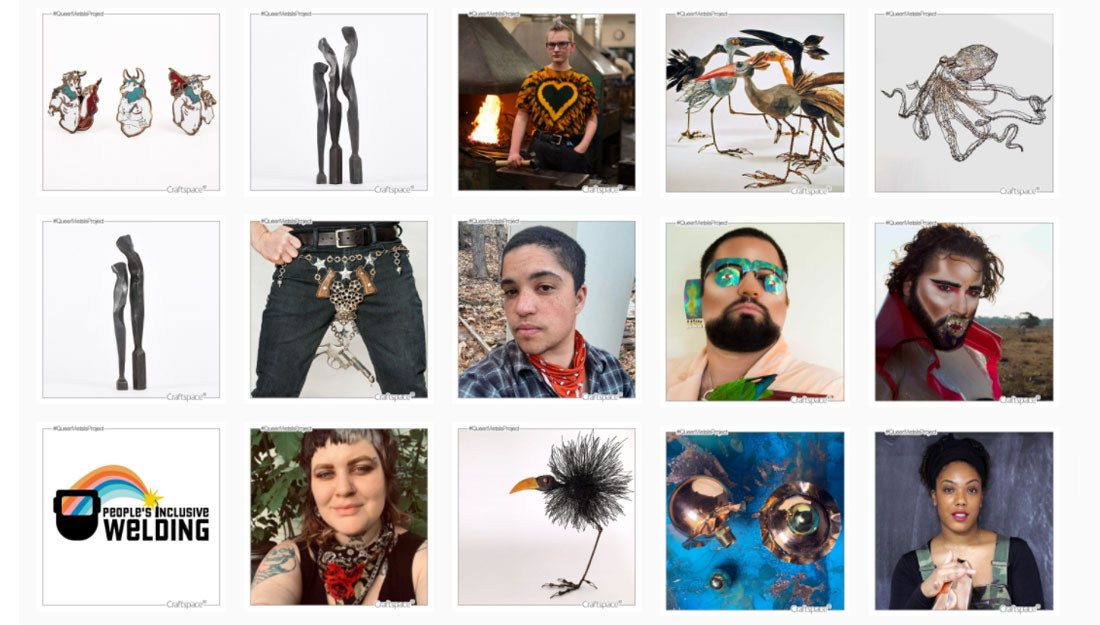
{Queer} + {Metals} Panel. Photo: Alexia Pepper de Caires
Introduction
Alongside the Queer + Metals exhibition, an international panel discussion held on 2 February 2023 explored ideas of transformation and queering materials, asking the question ‘How do ‘queerness’ and metalsmithing intersect?’
Chaired by Deirdre Figueiredo, Director of Craftspace, an online panel moderated by Rebekah Frank in San Francisco included: Marcelo Ferreira Gustafsson in Stockholm, Funlola Coker in New York and Eleanor Rose in Tennessee. An in-person UK panel included Daniel Fountain, Roxanne Simone and Dauvit Alexander.

Alexia Pepper de Caires, {Queer} + {Metals} Collage. Photo: artist
An essay by Alexia Pepper de Caires
Alexia Pepper de Caires (she/her) runs Back To Books @backtobooksbrum. Back to Books is a radical & representative bookspace for Birmingham.
Queer space is a verb, rather than a static construct.
To queer. To be queered.
In the modern experience queer space is so commodified and packaged back to us that truly queer space is almost never found.
In Craftspace’s creation {Queer} + {Metals} finds us as a tiny, inviting room of queer embodiment in the form of metal. With nothing asked of us as the viewing body but to just be. And here I notice again how rare quiet queer space is.
The panel conversations held in early February 2023 with artists, queer craft researchers and curators mirrored the tiny, quiet exhibition that holds riches and self-discoveries. We sat listening deeply to people in Birmingham, New York, Stockholm and San Francisco to learn what the words queer and metal had uncovered.
We welcomed the work of all eight artists into the room, some who were also present with us – Annie Higgins, Fei He, Dauvit Alexander, Gilbert Hadden, John Moore, Theo Somerville-Scott, Mark Newman, Roxanne Simone. And Rebekah Frank, Marcelo Ferreira Gustafsson, Eleanor Rose, Funlola Coker and Daniel Fountain came to share with us as researchers and makers who responded to the {Queer} + {Metals} question. The expansiveness of the question what does queer metal mean to you? was tangible in the evening’s conversation, explored without a reach for conclusions or definitions, and with the active intention of inclusion.

{Queer} + {Metals} exhibition at MAC, Birmingham. Photo: Tegen Kimbley
In opening the conversation our host Deirdre Figueiredo, Director of Craftspace, held out the nature of the {Queer} + {Metals} universe for us to see more clearly – fluid, connected, diverse, and designed to affirm, express, disrupt and show solidarity. What flowed in the talk were musings on the relationship between self as queer and artistic work as queer. Trial, error and evolution in queer identity, just like metalwork.
Making with the head, heart and hand as the creative process and not always stepping back to reflect on the queerness of the work, because it is deeply embedded and non-separate. Where intersections of power systems appear and act to withhold resources or enforce labels not felt in the making.
Perhaps to queer is also to notice, and in that noticing to decide to make something in response.
Rebekah Frank noticed the injustices of the US at the start of her conversation, especially at the start of US Black History Month. And that open question in her work gave the largest expanse for people to explore themselves and their work within queer and metal.
Funlola Coker noticed that working slowly and embracing slow work with no answers was an affirmation of their queer selves, and a process to connect with some kind of humanity. That to be untethered to one type of making was queer metal.
Marcelo Ferreira Gustafsson noticed he created wonder in himself in relation to materials in his work and could examine the hierarchy of ‘alive’ and ‘dead’, with space for the fluid. That the process of creation was a hunt for the spirituality of making itself.
Eleanor Rose noticed that a metal shop created the space for safety and acceptance, and grew her practice there in the affirming, unoppressive air.
A vibrant thread in this evening’s conversation was the politics of being queer, as fully integrated and deeply complex. Who gets to be outwardly queer – and where – was witnessed both within the world of metal and wood making, and beyond the making space in who gets granted a passport and whose nation recognises queer identity. Privilege and intersectionality were on the speakers’ lips to make visible the different power systems that queer sits in, reminding us that even while English powerholders seek to strip back trans rights we could still sit in a room and ‘together’ on queerness. Black artists know they are Black first, queer and working class the more hidden layers.

Roxanne Simone, Canopic at {Queer} + {Metals} MAC. Photo: Tegen Kimbley
Togethering as queers also showed up in conversation on the wider intentions of the artists and researchers.
Roxanne Simone’s work with hydroforming creates a high pressured process with subsequent healing – not repair – and her practice centres the diasporic experience. Her activism in metal making and as an educator is to intentionally create safe spaces for people who don’t see themselves in the structures, bringing to life the intersectionality needed to move beyond large identity labels towards the sensitivities of where queerness really sits within each of us.
Daniel Fountain chartered the journey of queer creating as anti-capitalist, decolonial making that doesn’t strive to create an object to be fetishised in the gallery. Queer creation as imperfect. The exploding and bursting of material. The process of making as the work itself, not the striving for completion.
This feels particularly important to hear when queer creativity become ever more mainstreamed and social media-ified in the pursuit of profit. To queer is to rebel and resist. In a visual world where queer aesthetics are now trying to sell me mortgages and the relationship between queer, class and money is never openly addressed, I felt a balm in remembering that queer is not product.
Dauvit Alexander shared his approach of mucking about as a strategy to cope with a social identity as the ‘other’ and how playfulness can open into to very serious conversation. He witnessed how easily queer safe space can be removed with the presence of a gun.
We learned of practices of community building within the metal world that bring Black, indigenous and creatives of colour together and provides space to collaborate and support. Roxanne noticed that the lens of ‘ethnic’ work is deeply dehumanising, yet still in use. She calls for makers to be allowed to determine what their work is about and informed by, and to know which parts of the patchwork of their own identity shows up.
Held during the observing months of UK LGBT+ History Month and US Black History Month, the talk ended with two comments from the floor that uplifted the need to reclaim queer history and to know who came before us, and a deep appreciation for this space.
To queer is to question, especially in a westernised whitened world where most of us must mine inwards to find our queerness. What is {Queer} + {Metal} to us?


